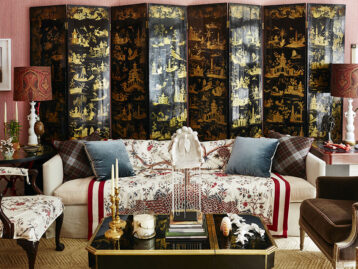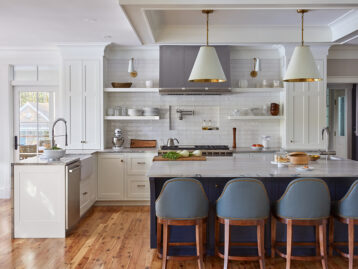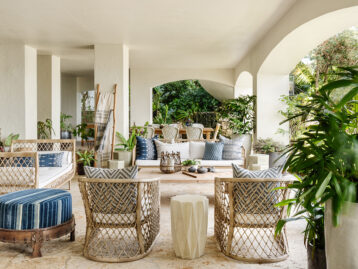Like many interior designers, Victoria Taylor evolved her business in a way she never truly expected. After running her own firm from her native California for over 20 years, she decided to order some vintage poufs from a friend who had moved to Morocco. After receiving them and using them in her projects… she was hooked. Taylor, who also previously ran an import business for antique Chinese furniture, had found the next chapter in her life.
She launched Le Foundouk to bring the work of Moroccan artisans to a wider audience in the U.S., sharing poufs, rugs, blankets, and more with her clients. She’s even begun working with woven chandeliers and is expanding to more varied categories. We spoke with Taylor about the creation of her business, the pieces she loves the most, and her passion for “anti-decor.” Learn more below, and be sure to shop everything Le Foundouk has to offer.
Shop Le Foundouk
Product_id 3207326 not found
Product_id 894687 not found

How did Le Foundouk get its start? What’s the meaning behind the name?
After 20 years as an interior designer, I needed a change and I wanted to travel and create a business that would align with that. I had a friend who had moved to Morocco and she had been telling me about the amazing textiles and artisans she was finding. In 2009, I decided to buy three poufs and see what they were like. This began my love affair with the rugs and textiles—the artistry and culture. The collection has now expanded to other countries and continues to evolve. “Le Foundouk” is an old Berber term for where travelers would bring their camels or donkeys to stable them for the night after arriving in a village. The “barn” if you will…
You carry a chic curation of vintage and antique rugs, lighting, and pillows. How do you manage your sourcing?
I travel to Morocco once or twice a year and travel through the country; each rug is hand selected. Our pillows and blankets are my own designs and I create all the poufs from vintage rugs. The Italian lighting is sourced directly from Italy and I plan to expand in the near future. I also have a new collection of custom woven chandeliers that are made by a women’s collective in Morocco.
Shop Le Foundouk
Product_id 894709 not found
Product_id 2061178 not found
Product_id 2061080 not found
Product_id 2711177 not found

In particular, you have a lot of vibrant, fascinating rugs. Why should people consider colorful floor coverings? Do you have any advice for people who might be nervous about using color on their floors?
“The floor is the fifth wall of the room. You decorate the walls, but the floor is absolutely crucial to a room’s design, and the rug acts as the anchor.”—Jean-Pierre Tortil. These mid-century pieces are ”floor art” and make every other aspect in a space feel more elevated. If there is an ability to start with the rug when designing a space, the rug will almost certainly serve as an amazing focus when designing the room.
How was sourcing affected by the pandemic, and how did it affect business overall? Did you pivot the way you work as a result of changes in the industry over the last 2.5 years?
I was fortunate to have established myself abroad and was able to curate a collection through my contacts during the pandemic. It was a bit challenging but successful. I was also grateful to have an online business as well as a designer client base since so many people were remodeling and revamping their homes.
Have you seen more customers coming through digital methods like Chairish? Do you see that having an effect on how designers shop for vintage, in particular?
Absolutely; exposure is everything for a boutique business like mine since I don’t have a storefront. For clients to be able to shop online gives them so much more access to what’s available.

What types of pieces do you see moving these days? What are the patterns in terms of what’s selling right now?
I would say the softer palette is selling really well right now. One-of-a-kind, unique mid-century rugs are extremely popular for the client who doesn’t want a commercial feel. There’s no competition since each piece is its own individual masterpiece. I myself have been drawn to more muted colors recently but still love a bold design pattern.
What’s a dream piece you’d love to own yourself?
I love our long hair Russian rugs and would love to put one in my living room. Maybe next year, when the supply is better, as right now they are taking over six to nine months to receive.
Do you see any upcoming trends in terms of what’s next for the design world? What types of pieces do you hope to stock next?
My passion for my business comes from a desire to dazzle. I don’t really pay attention to the trends—I only want what surprises me. I would say that I just strive to source and curate an avant garde collection of unique statement pieces that create a sense of art, wonder, and design. I am in perpetual search for unusual and extraordinary vintage pieces which pair well with the elegance of modern design, creating understated sophistication.
Shop Le Foundouk
Product_id 4242540 not found
Product_id 1537020 not found
Product_id 4230843 not found

Are there any styles or trends you’d like to see disappear in the design world right now?
Contrived design, deliberate matching, beige? My rule is that… there are no rules. I like to blend colors, time periods, and really any design style that speaks to me. Keep it simple, mix vintage with new, and allow your memories and treasures brought home from travels to shape the space rather than sticking to any particular interior style.
Who are some of your favorite makers or designers, in terms of your own inspirations?
I am a huge fan of Tony Duquette and share a similar taste in my own aesthetic. I also resonate with designers such as Madeleine Castaing and Alexandre Coulonne. I believe in anti-decor. The rule I follow when decorating is “chiner,” which means looking in many secondhand shops to find the perfect pieces. Nothing can be too arranged and stable. I like to assemble things that shouldn’t be together in the first place, creating awkward juxtapositions.
Shop Le Foundouk
Product_id 1896629 not found
Product_id 3036937 not found
All images courtesy of Le Foundouk



















